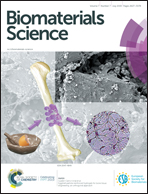Dual-loaded, long-term sustained drug releasing and thixotropic hydrogel for localized chemotherapy of cancer†
Abstract
Localized cancer chemotherapy is an intra-tumoral treatment and can effectively prevent locoregional recurrence. In this study, we proposed an environmentally–friendly method to load both hydrophilic (Doxorubicin, Dox) and hydrophobic (Curcumin, Cur) drugs into one hydrogel. The hydrogel was composed of two naturally derived polymers, regenerated silk fibroin (RSF) and hydroxypropylcellulose (HPC), and was endowed with thixotropic properties because of its differently crystalized β-sheet region. Moreover, by taking advantage of the specific interactions between Cur and the β-sheet region in the hydrogel, the solubility and stability of the hydrophobic Cur were dramatically improved. Because the multiple interactions between the two drugs and the hydrogel lead to different release profiles for Cur and Dox, the dual-drug loaded hydrogel presented superior long-term sustained antitumor efficacy compared with the free drug and the Dox single-loaded hydrogel. The dual-drug loaded hydrogel exhibited an enhanced therapeutic effect and a reversal of multiple drug resistance (MDR) to Dox. Moreover, by investigating the mechanism of the thixotropicity of our hydrogel, we concluded that this property results from the slipping and deformation of β-sheet enriched domains as well as the destruction/reconstruction of weak crosslinks.



 Please wait while we load your content...
Please wait while we load your content...